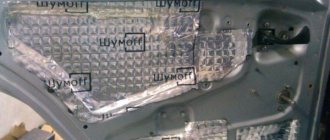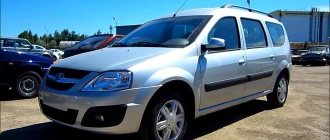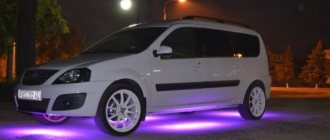It is impossible to say exactly how much paint will be spent on painting a car, but there are basic principles that will help you understand the paint consumption when painting a car body.
The amount of paint is affected by:
- Machine size
- Paint color and original body color
- Paint quality
- Spray gun type
- Painter experience
Let's take a closer look at each point.
Paint color and original body color
The amount of paint required to paint a car depends on what color the car will be painted and what the original color of the surface to be painted is. If the body panel has a color contrasting to the one being sprayed, then more paint will be needed. Colors such as yellow, red, and blue are low opaque, so more paint may be needed to cover the original color. If the paint has low coverage, then it is necessary to apply more layers to paint the substrate. For example, when painting with red and yellow paint, up to 10 or more layers may be required.
Colors such as black, white, and bright green have good hiding power.
If a car is repainted due to numerous minor defects and scratches that are sanded off during preparation of the body for painting, then less paint will be used than when changing the color of the car.
The color of the substrate will affect the final shade of the paint.
Note: Hiding power is the ability of paint, when sprayed, to completely cover the color of the surface, that is, to cover the color of the substrate with the sprayed color. Thus, the more opaque the paint, the less it will be needed to paint the part.
Which car paint is better to choose?
For painting your car yourself, there are the following types of paints:
- acrylic;
- alkyd;
- nitro enamels;
- cellulose;
- metallics;
- Griftal.
Each tool has its own advantages and disadvantages.
Acrylic enamel is most in demand; it is suitable for complete repainting of the car. Its features:
- easy to use;
- lays down evenly;
- dries quickly;
- the resulting surface is resistant to solvents, reflects light well, and therefore does not require varnishing;
- due to insufficient covering power it is necessary to apply 2-3 layers.
The surface covered with hard-setting acrylic enamel is durable, while the soft-setting type is highly polished.
Alkyd enamel is suitable when you need to paint a small area. Its features:
- low cost (cheaper than acrylic);
- easy application;
- good covering power, it is enough to apply 1-2 layers;
- dries slowly (this process can be influenced by adding an accelerator to the enamel or increasing the drying temperature);
- The surface is difficult to polish and needs to be varnished.
Nitroenamel is considered an outdated product, but it is used to eliminate minor defects. Its characteristics:
- dries well;
- fades quickly;
- flammable;
- Polishing and varnishing are required to achieve shine.
Cellulose paint has similar properties.
Metal enamels have a complex composition and manufacturing technology. They are used to eliminate small chips or scratches on parts originally painted with this type of paint. Cover the surface with 1-3 layers. It is not recommended to completely paint your car with metallic enamel, because... Without special skills, it is difficult to achieve good quality coating in a garage.
Pay attention to: How to paint car rims with your own hands using a spray can: features of self-processing
Glypthal paints have the following properties:
- create a thick film;
- takes a long time to dry (at a temperature of +20...+25°C, the coating hardens within a day, and complete drying may take up to 1 month);
- the surface does not need polishing.
Spray gun type
Paint consumption is significantly affected by the design of the spray gun. HVLP spray guns have a high percentage of paint and varnish material transfer to the surface being painted. For high-quality HVLP spray guns, this percentage is at least 75%. When painting with such spray guns, the paint gets onto the part as much as possible, and does not fly to the sides.
From personal experience I can say that when I take high-quality paint in the quantity recommended for painting the parts I need, the paint often remains (sometimes more than half). I paint with an Iwata W‑101 spray gun, purchased from an official representative in Russia. From my own experience I am convinced that a high-quality, economical spray gun significantly reduces paint consumption.
Painter experience
The amount of paint required to paint a car body also depends on the professionalism of the car painter. An experienced painter will set up the paint gun correctly and distribute the paint correctly. The paint should not be applied in the form of dust, but should spread well when it hits the surface. It is wiser to first paint over repair areas and replacement body panels that are a different color than the rest of the body. Then you can proceed to the step-by-step painting of all body parts.
Base paint + varnish
If the car will be painted with paint that requires further varnish, then more varnish may be required than base paint. It is necessary to create a certain thickness with varnish, since it is a protective coating. For example, if it takes about 2 liters of base paint to paint the body, then 3 – 3.5 liters of varnish may be required. Even if a smaller amount of varnish is used, it is better to take it in reserve and dilute it not all at once, but as it is used. The remaining, undiluted varnish will be useful in the future when painting any car.
In general, the amount of varnish depends on the area to be varnished, and not on the amount of base paint. The amount of paint and varnish may be the same.
We determine the list and quantity of materials for refreshing the paint
There is an opinion, which is confirmed by many masters, that 3 liters of paint are needed to refresh the entire car. But let's not forget that we need to take into account the dimensions of each part. For example, for a VAZ 2110 this amount of material may actually be enough if used skillfully. But to work with Mitsubishi Pajero, other quantities are needed. Approximate calculations of how much material is needed for your machine can be taken from the following considerations:
- A-class, small hatchbacks, will require about 2.5 liters of alkyd enamel for exterior painting;
- B-class cars need 3 liters for that very job;
- to paint cars in the comfort segment, which are the majority, you will need 3.5 liters;
- business class cars will require up to 4.5 liters for external processing;
- for jeeps and large crossovers you need 4-5 liters of high-quality paintwork;
- a van, for example, can be painted with 4 liters, but it is better to use more layers.
It is worth considering that the amount of paint spent depends very much on the manufacturer of the material, its cost and level. The professionalism of the process executor also influences the consumption. A car can be painted with just one small can of enamel, but the results of such a process are unlikely to please you with their high quality. You can find out about the quantity of paint and varnish materials needed when purchasing from a professional store.
If we are talking about spray cans, you should count one aerosol can of paint per 0.3 m2 of area. But remember that it is simply impossible to produce high-quality car painting from a spray can.
How long does it take for paintwork to dry after painting a car?
After completing all the processes in the chamber, the machine should stand in a dry space for another hour. After this, you can take it out into the open air and give it another 3-4 hours so that the body can dry well. In sunlight at a temperature of about 20 degrees, everything happens faster.
Calculations are given if alkyd enamel was used. Expensive metallic may take longer to dry. Also, the time during which the paint begins to dry well is determined by the amount of hardener added. Remember that interior spaces take longer to dry. Full operation can begin 14-15 days after completing all procedures with the machine.
How long after painting can you wash your car?
Normal drying time should always be allowed. If you start washing the car or polishing surfaces after two to three hours, you will have to paint the body again. Before answering the question of how long after you can start washing your car and preparing it for a trip, you need to understand what type of paint was used. There are types of car enamels that can be washed after a day, and this will not cause any harm. But most inexpensive materials need 7-9 days to dry completely.
After this, you need to conduct a visual audit of the results to identify all the shortcomings. You can also do a deep polish in case of many troubles. After a few days of leaving the car outdoors, you can safely wash it and do all the necessary cosmetic procedures.
The amount of paint required to paint the entire car
If you use paint economically, you may need 2 kg of paint for the entire car. You need about the same amount of varnish.
Basically, 2–2.5 kg of undiluted paint is enough to paint a four-door sedan. Since the base paint is diluted 1 to 1 (1 liter of paint is mixed with 1 liter of thinner), you will get twice as much diluted paint.
If the car needs to be painted along with all the openings, then you will need 0.5 - 1 kg more paint. Since the base paint is usually diluted 1 to 1, the amount of paint diluted for spraying will be 2 times greater.
We determine the paint consumption for painting a car. Table for calculating the required volume of material.
When you paint a car yourself, you save a lot of money, which is why many people are interested in the question of the technology for carrying out all the work. But one of the main questions that worries novice car painters is: “What is the paint consumption for a car?” Paint is not a cheap material at all, and you don’t really want to buy too much; you’ll end up throwing money away. You will not be able to get an exact answer to this question, since many factors influence the volume of material.
What affects consumption?
At first glance, the main parameters include the surface area that needs to be processed and the number of layers of material that are planned to be applied.
But in fact there are other factors.
- technology of applying the material by a master. This includes the ability to spray an even layer of material without overspray.
- thickness and number of paint layers.
- type of paint and its parameter such as surface coverage.
- paint viscosity. If the paint is diluted too little with solvent, it will be viscous, and the dried surface will have a shagreen effect. If the material is heavily diluted, there is a high probability of smudges. The best solution, if possible, would be to use a viscometer and strictly follow the instructions provided by the manufacturer.
- color and quality of the prepared surface. This step can also significantly reduce your car's paint costs. A well-sanded P800 - P1000 primer surface and a good primer that matches the basecoat tone can reduce the number of coats of paint applied and save you money.
- spray gun settings. Here, first of all, there is a question of choosing the diameter of the nozzle and the uniformity of air supply from the compressor. It is advisable to first try to apply a layer of material on a test surface, and then begin finishing the car.
- temperature of the working environment in the room.
Related article: Restoring the paint layer of your car using a scratch removal pencil
In particular, many craftsmen recommend the use of primers, paints and varnishes from the same manufacturer. This way, you can avoid defects and save on car paint consumption for all sorts of alterations.
Which paint should you choose for your car?
In fact, there are several different types of auto enamels that are used to apply to the car body at home.
- Nitro enamels. They are characterized by a number of disadvantages. Firstly, they are flammable. Secondly, they quickly fade and collapse. Thirdly, they are usually applied in a thin layer and you will need several coats. They are being replaced on the market by more modern solutions.
- Glypthal. These materials take a very long time to dry, taking 2 to 4 weeks, and for drying itself it is necessary to maintain fairly high temperatures.
- Acrylic enamels. These are the most popular types of material on the market. They dry quickly and the end result is a high quality surface. They are usually two-component and during operation are diluted with a hardener, which speeds up the polymerization process. You can use varnish in combination to add shine. In most cases they are applied either with a spray gun or a spray can.
- Alkyd paints. Compared to acrylic materials, they take longer to dry and are difficult to polish.
Car paint consumption rates
On average, to paint, for example, a door or fender, you will need about 150 ml of paint, about 250 - 300 ml of material for a bumper, and about 600 ml for a hood.
On average, the consumption rate is 200-250 ml per 1 sq.m. treated surface. The varnish consumption is approximately the same, this does not take into account the solvent and hardener.
An average sedan, if the technology is followed, requires about 2 - 2.5 liters of acrylic paint, excluding solvent and hardener. If you use alkyd paint, its consumption will be slightly higher than 3 - 3.5 liters. If your task is to paint all surfaces inside the body, then the material consumption will increase by 1.5 - 2 times.
Related article: Painting calipers is a small detail that makes your car even more expressive
If, when repainting a part, the old paint was, for example, black, and you decided to apply a white layer, then the consumption will increase by 50%. This occurs due to the application of additional overlapping layers.
We will provide a table that will help you roughly navigate the paint consumption for individual parts of the car body.
Here is a useful video on the topic of calculating material consumption when painting a car.
What if you use aerosol cans?
They are mainly used for local repairs, and one can has a volume of 150 grams of paint. The average paint consumption for painting a car using an aerosol can will be from 0.25 sq.m. up to 0.5 sq.m.
For 1 sq.m. For the surface to be treated, we will need about 2 - 4 cans of paint and the same amount of varnish.











